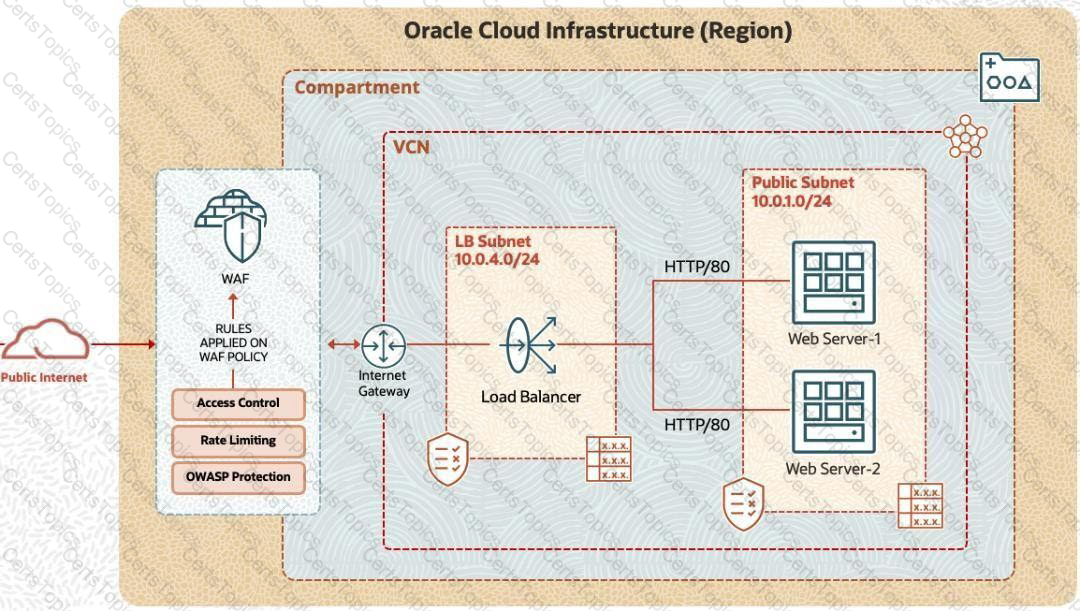An automobile company needs to configure Bastion Managed SSH session to a compute
instance in a private subnet. What are the TWO prerequisites to configure successfully?
You know that a few buckets in your compartment should stay public, and you do not want Cloud Guard to detect these as problems. In which two ways would you address this? (Choose two.)
You are using a custom application with third-party APIs to manage application and data hosted in an Oracle Cloud Infrastructure(OCI) tenancy. Although your third-party APIs don't support OCI's signature-based authentication, you want them to communicate with OCI resources. Which authentication option must you use to ensure this?
You need to create matching rules for a conditional policy. Which TWO matching rules syntax can be used? (Choose two.)
A company has OCI tenancy which has mount target associated with two File Systems, CG_1 and CG_2. These FileSystems are accessed by IP-based clients AB_1 and AB_2 respectively. As a security administrator, how can you provide access to both clients such that CGI has Read only access on AB1 and CG_2 has Read/Write access on AB_2?
Which storage type is most effective when you want to move some unstructured data, consisting of images and videos, to cloud storage?
When doesCloud Guard re-open an issue and update the history?
You have subscribed to a tenancy, in which you want to isolate the OCI resources from different users logically for governance. Which OCI resource will help you achieve logical separation? (Choose the best Answer.)
You are using a custom application with third-party APIs to manage application and data hosted in an Oracle Cloud Infrastructure (OCI) tenancy. Although your third-party APIs do not support OCI's signature-based authentication, you want them to communicate with OCI resources Which authentication option should you use to ensure this? (Choose the best Answer.)
Which statement about Oracle Cloud Infrastructure Multi-Factor Authentication (MFA)is NOT valid?
your company has hired a consulting firm to audit your oracle cloud infrastructure activity and configuration you have created a set of users who will be performing the audit, you assigned these user to the orgauditgrp group. the auditor required the ability to see the configuration of all resources within tenant and you have agreed to exempt the dev compartment from the audit.
which IAM policy should be created to grant the orgauditgrp the ability to look at configuration for all resources except for those resources inside the dev compartment?
In Oracle Cloud Infrastructure (OCI) Secret management within OCI Vault, you have created a secret and rotated the secret one time. The current version state shows: Version Number | Status 2 (latest) | current 1 | Previous In order to rollback to version 1, What should the Administrator do? (Choose the best Answer.)
What must be configured for a load balancer to accept incoming traffic?
How can you establish private connectivity over two VCN within same OCI region without traversing the traffic over public internet ?
How can you restrict access to OCI console from unknown IP addresses?
Which VCNconfiguration is CORRECT with regard to VCN peering within a same region ?
A http web server hosted on an Oracle cloud infrastructure compute instance in a public subnet of the vcsl virtual cloudnetwork has a stateless security ingress rule for port 80 access through internet gateway
stateful network security group notification for port 80 how will the Oci vcn handle request response traffic to the compute instance for a web page from the http server with port 80?
Which tasks can you perform on a dedicated virtual machine host?
With regard to vulnerability and cloud penetration testing, which rules of engagement apply? Select TWO correct answers.
You are tasked with building a highly available, fault tolerant web application for your current employer. The security team is concerned about an increase in malicious web-based attacks across the Internet and therefore wants to add a higher level of security to the website. How would you architect the solution in Oracle Cloud Infrastructure (OCI) to meet the security requirements defined by your organization? (Choose the best Answer.)
As a Security Admin you want to inspect the metadata and actual data in your Oracle databases to discover sensitive data and provide comprehensive results listing the sensitive columns and related information. Which Data Safe feature will help you to achieve the above requirement ?
Which is NOT a compliance document?
Which type of FastConnect supports configuring Oracle Cloud Infrastructure (OCI) Site-to-Site VPN for encryption? (Choose the best Answer.)
You are the first responder of a security incident for ABC Org. You have identified sever-al IP addresses and URLs in the logs that you suspect may be related to the incident. However, you need more information to confidently determine whether they are indeed malicious or not. Which OCI service can you use to obtain a more refined information and confidence score for these identified indicators? (Choose the best Answer.)
"Jazz Clothing" is an e-commerce company that wants to secure their in-transit communication to online store's hosted on Oracle Cloud Infrastructure (OCI) by ensuring secure Transport Layer Security (TLS) connections. They plan to automate the process of creating and rotating certificates using the OCI Certificates service to avoid outages due to expired certificates. What is a key benefit that Jazz Clothing will gain by automating their certificate management for TLS connections in OCI? (Choose the best Answer.)
Challenge 1 - Task 2 of 5
Authorize OCI Resources to Retrieve the Secret from the Vault
Scenario
You are working on a Python program running on a compute instance that needs to access an external service. To access the external service, the program needs credentials (password). Given that it is not a good security practice, you decide not to hard code the credential in the program. Instead, you store the password (secret) in a vault using the OCI Vault service. The requirement now is to authorize the compute instance so that the Python program can retrieve the password (secret) by making an API call to the OCI Vault.
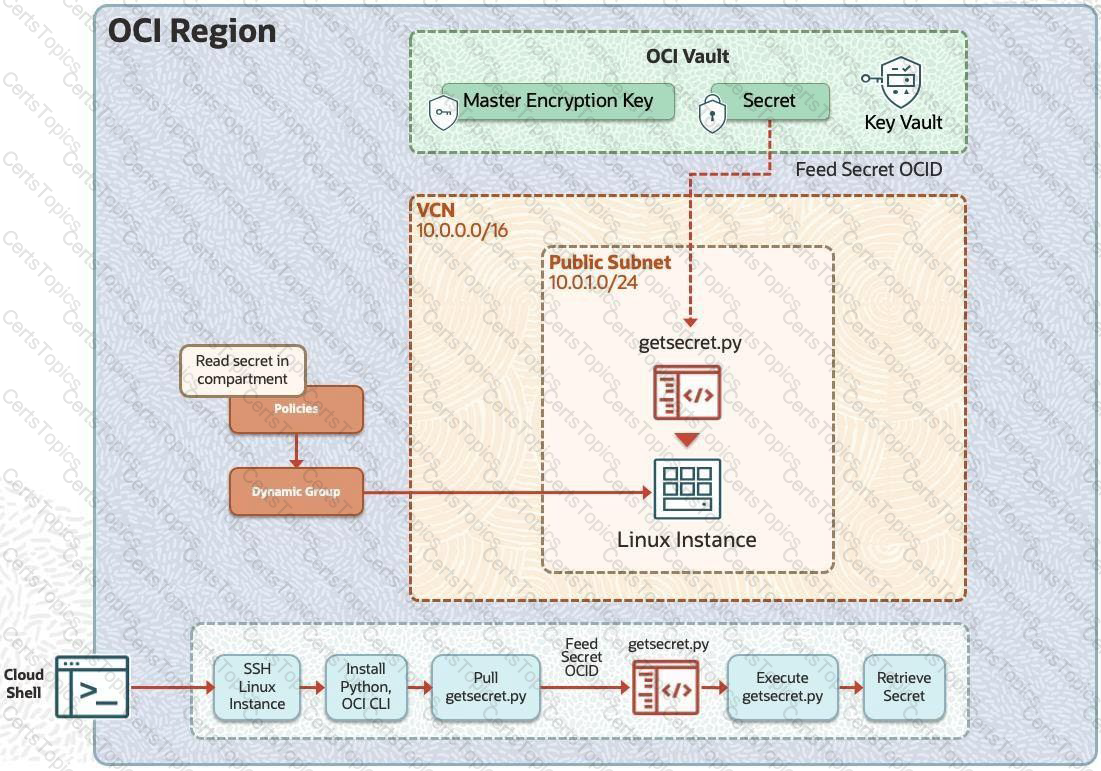
Preconfigured:
To complete this requirement, you are provided with:
Note: You are provided with access to an OCI Tenancy, an assigned compartment, and OCI credentials. Throughout your exam, ensure to use the assigned Compartment 99234021-C01 and Region us-ashburn-1.
Complete the following task:
In the field below, write the IAM policy, which allows a program running on a computer instance (principal instance) to retrieve a secret from the OCI Vault.
Challenge 4 - Task 1 of 6
Configure Web Application Firewall to Protect Web Server Against XSS Attack
Scenario
You have to protect web applications hosted on OCI from cross-site scripting (XSS) attacks. You can use the OCI Web Application Firewall (WAF) capabilities to create rules that compare against incoming requests to determine if the request contains an XSS attack payload. If a request is determined to be an attack, WAF should return the HTTP Service Unavailable (503) error.
To ensure that the configured WAF blocks the XSS attack, run the following script: /index.html? ) To complete this deployment, you have to perform the following tasks in the environment provisioned for you: Note: You are provided with access to an OCI Tenancy, an assigned compartment, and OCI credentials. Throughout your exam, ensure to use the assigned Compartment 99233424-C01 and Region us-ashburn-1. Complete the following task in the provisioned OCI environment: Create a VCN using wizard with the name IAD-WAF-PBT-VCN-01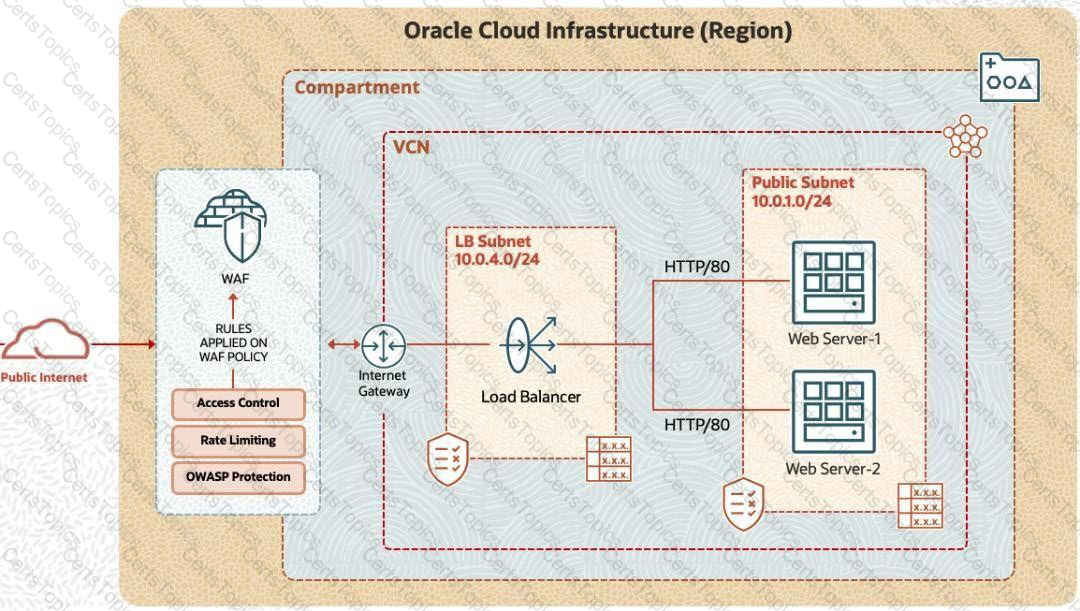
Challenge 3 - Task 4 of 4
Set Up a Bastion Host to Access the Compute Instance in a Private Subnet Scenario
A compute instance is provisioned in a private subnet that is not accessible through the Internet. To access the compute instance resource in a private subnet, you must provide a time-bound SSH session without deploying and maintaining a public subnet and a jump server, which eliminates the hassle and potential attack surface from remote access.
To complete this deployment, you have to perform the following tasks in the environment provisioned for you:
• Configure a Virtual Cloud Network (VCN) and a Private Subnet.
• Provision a Compute Instance in the private subnet and enable Bastion Plugin.
• Create a Bastion and Bastion session.
• Connect to a compute instance using Managed SSH session.
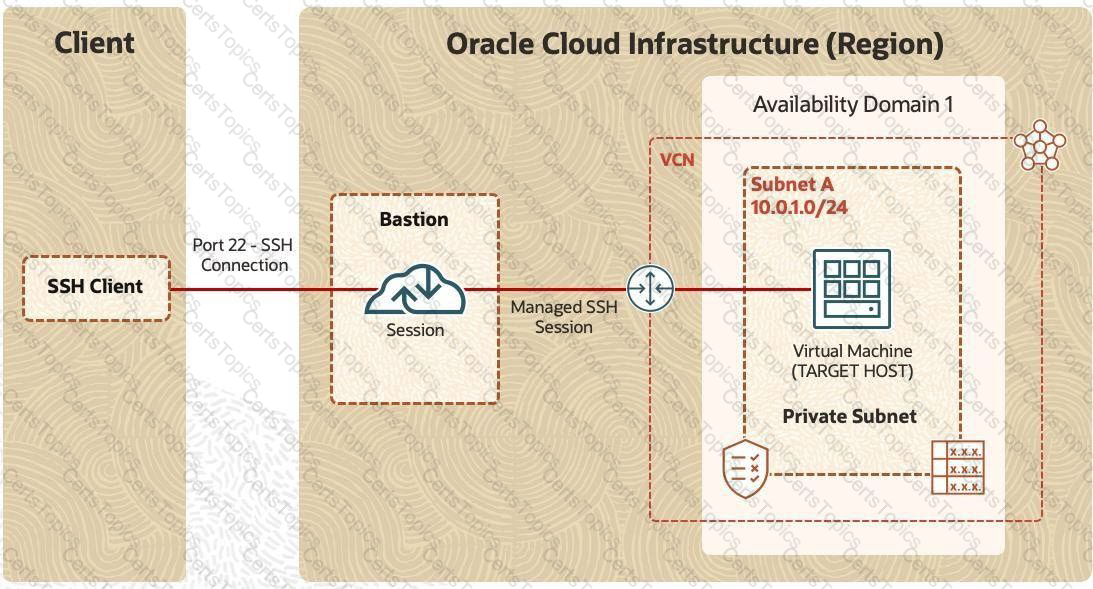
Note: You are provided with access to an OCI Tenancy, an assigned compartment, and OCI credentials. Throughout your exam, ensure to use the assigned Compartment 99233424-C01 and Region us-ashburn-1
Complete the following tasks in the provisioned OCI environment:
Connect to a compute instance using a Managed SSH Bastion session from your local machine terminal or Cloud shell.
Challenge 3 - Task 3 of 4
Set Up a Bastion Host to Access the Compute Instance in a Private Subnet Scenario
A compute instance is provisioned in a private subnet that is not accessible through the Internet. To access the compute instance resource in a private subnet, you must provide a time-bound SSH session without deploying and maintaining a public subnet and a jump server, which eliminates the hassle and potential attack surface from remote access.
To complete this deployment, you have to perform the following tasks in the environment provisioned for you:
• Configure a Virtual Cloud Network (VCN) and a Private Subnet.
• Provision a Compute Instance in the private subnet and enable Bastion Plugin.
• Create a Bastion and Bastion session.
• Connect to a compute instance using Managed SSH session.
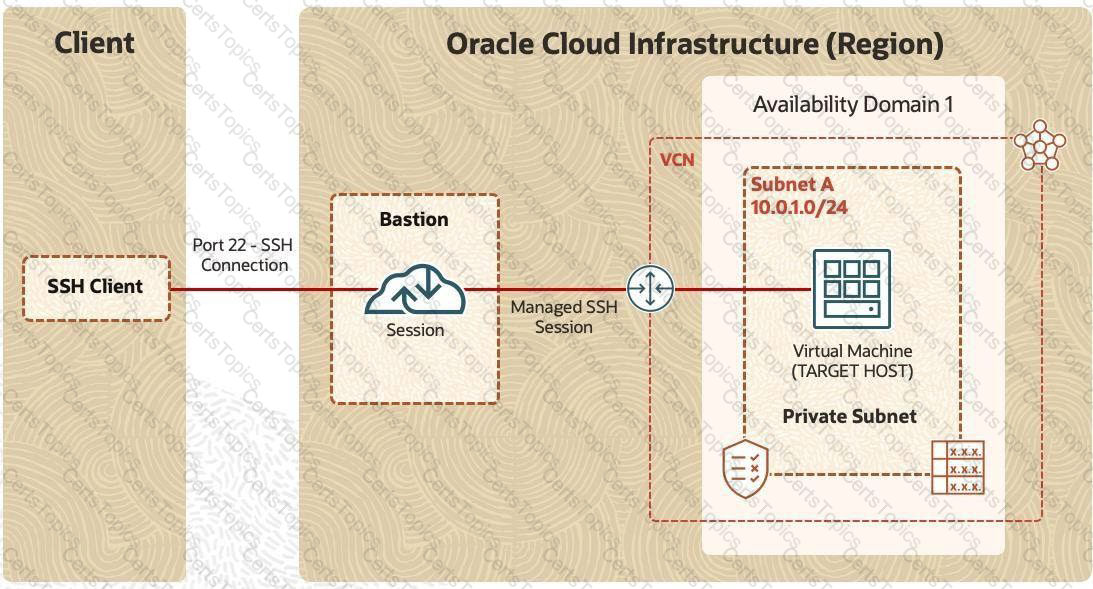
Note: You are provided with access to an OCI Tenancy, an assigned compartment, and OCI credentials. Throughout your exam, ensure to use the assigned Compartment 99233424-C01 and Region us-ashburn-1
Complete the following tasks in the provisioned OCI environment:
1. Create a Bastion with the name SPPBTBASTION99233424-lab.user01
[Eliminate Specical Characters] Eg:SPPBTBASTION992831403labuser13
2. Create a Session with the name PBT-1-Session-01, for compute instance in private subnet, with default username as "opc"
Challenge 3 - Task 2 of 4
Set Up a Bastion Host to Access the Compute Instance in a Private Subnet Scenario
A compute instance is provisioned in a private subnet that is not accessible through the Internet. To access the compute instance resource in a private subnet, you must provide a time-bound SSH session without deploying and maintaining a public subnet and a jump server, which eliminates the hassle and potential attack surface from remote access.
To complete this deployment, you have to perform the following tasks in the environment provisioned for you:
• Configure a Virtual Cloud Network (VCN) and a Private Subnet.
• Provision a Compute Instance in the private subnet and enable Bastion Plugin.
• Create a Bastion and Bastion session.
• Connect to a compute instance using Managed SSH session.
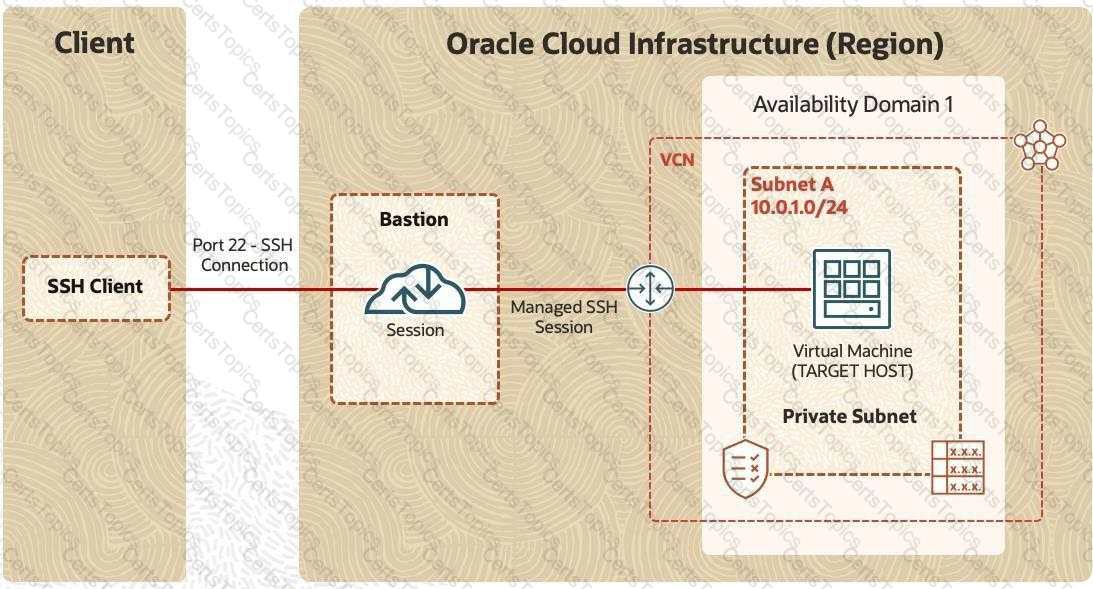
Note: You are provided with access to an OCI Tenancy, an assigned compartment, and OCI credentials. Throughout your exam, ensure to use the assigned Compartment 99233424-C01 and Region us-ashburn-1
Complete the following tasks in the provisioned OCI environment:
Create a Compute Instance with the name PBT-BAS-VM-01, using the "Oracle Linux 8" image and shape "VM.Standard2.1", without SSH key and enable Bastion plugin.
Challenge 1 - Task 3 of 5
Authorize OCI Resources to Retrieve the Secret from the Vault
Scenario
You are working on a Python program running on a compute instance that needs to access an external service. To access the external service, the program needs credentials (password). Given that it is not a best security practice, you decide not to hard code the credential in the program. Instead, you store the password (secret) in a vault using the OCI Vault service. The requirement now is to authorize the compute instance so that the Python program can retrieve the password (secret) by making an API call to the OCI Vault.
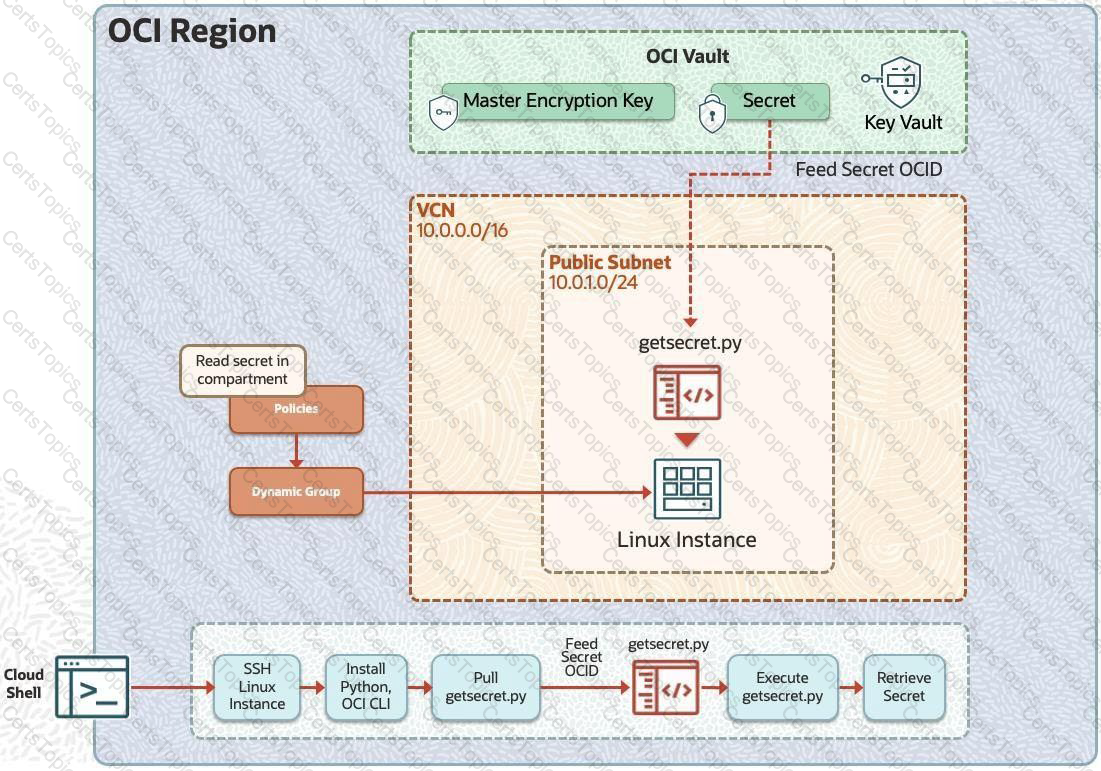
Preconfigured
To complete this requirement, you are provided with:
Note: You are provided with access to an OCI Tenancy, an assigned compartment, and OCI credentials. Throughout your exam, ensure to use the assigned Compartment 99234021-C01 and Region us-ashburn-1.
Complete the following task in the OCI environment provisioned:
Create a new VCN with the name PBT_SECRET_VCN01 and public subnet within your assigned compartment.
Challenge 1 - Task 4 of 5
Authorize OCI Resources to Retrieve the Secret from the Vault
Scenario
You are working on a Python program running on a compute instance that needs to access an external service. To access the external service, the program needs credentials (password). Given that it is not a best security practice, you decide not to hard code the credential in the program. Instead, you store the password (secret) in a vault using the OCI Vault service. The requirement now is to authorize the compute instance so that the Python program can retrieve the password (secret) by making an API call to the OCI Vault.
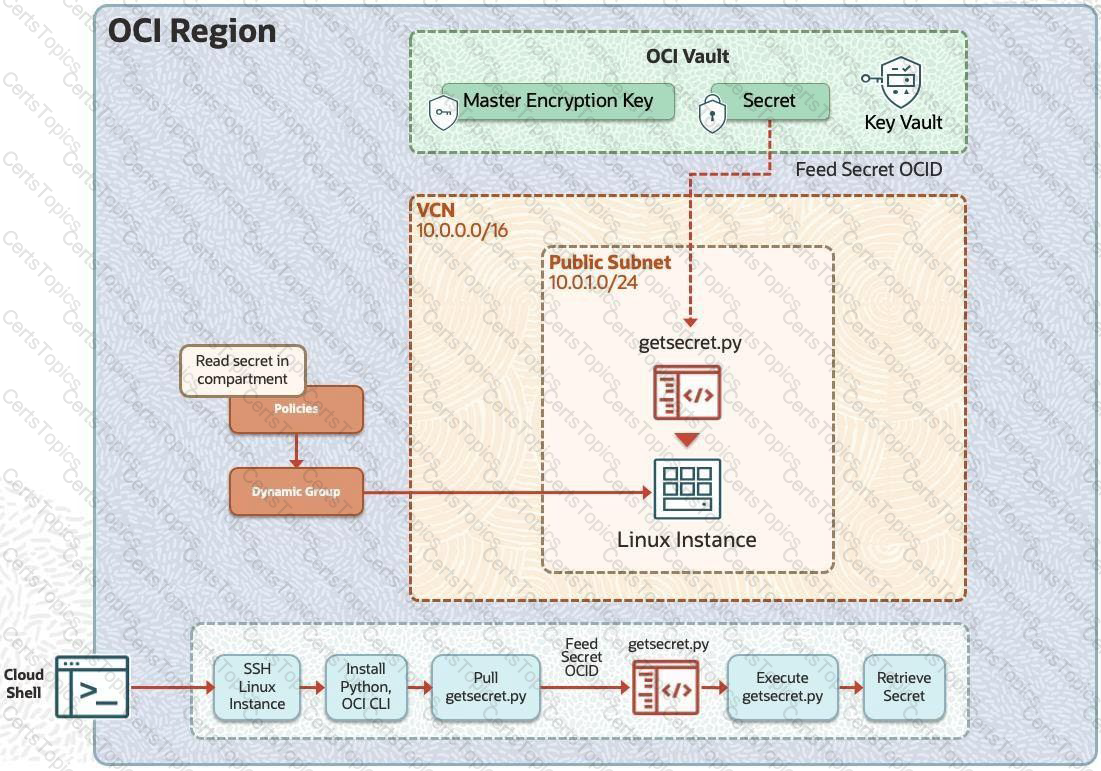
Preconfigured
To complete this requirement, you are provided with:
Note: You are provided with access to an OCI Tenancy, an assigned compartment, and OCI credentials. Throughout your exam, ensure to use the assigned Compartment 99234021-C01 and Region us-ashburn-1.
Complete the following tasks in the OCI environment provisioned:
Provide your own public key to SSH the instance.
Challenge 4 - Task 6 of 6
Configure Web Application Firewall to Protect Web Server Against XSS Attack
Scenario
You have to protect web applications hosted on OCI from cross-site scripting (XSS) attacks. You can use the OCI Web Application Firewall (WAF) capabilities to create rules that compare against incoming requests to determine if the request contains an XSS attack payload. If a request is determined to be an attack, WAF should return the HTTP Service Unavailable (503) error.
To ensure that the configured WAF blocks the XSS attack, run the following script: /index.html? ) To complete this deployment, you have to perform the following tasks in the environment provisioned for you: Note: You are provided with access to an OCI Tenancy, an assigned compartment, and OCI credentials. Throughout your exam, ensure to use the assigned Compartment 99233424-C01 and Region us-ashburn-1. Complete the following task in the provisioned OCI environment: You will connect to the web server and append an XSS script. The protection rule will evaluate the requests and respond accordingly.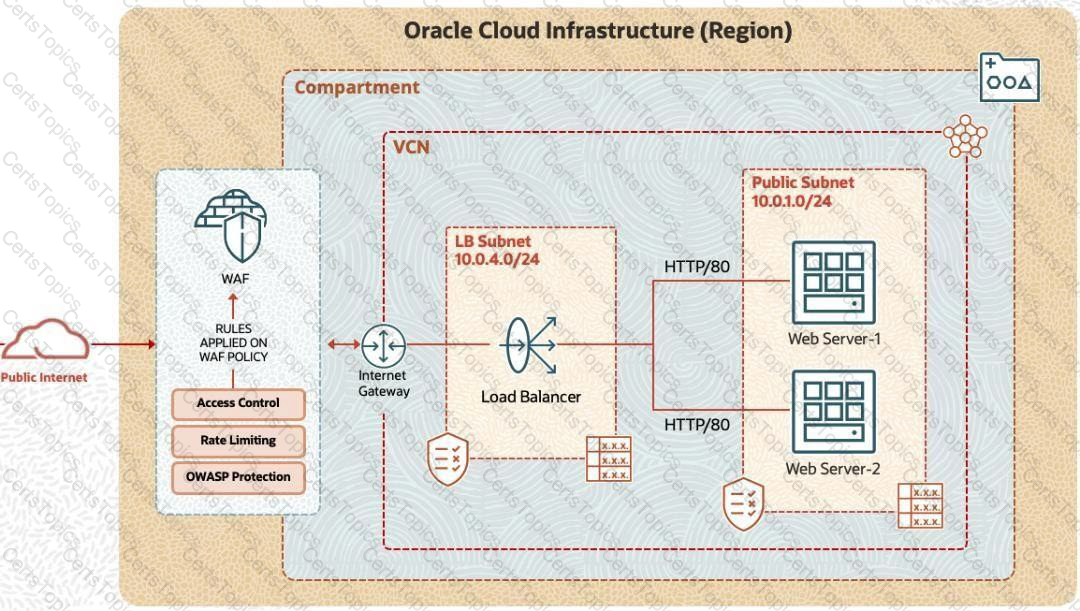
Challenge 4 - Task 5 of 6
Configure Web Application Firewall to Protect Web Server Against XSS Attack
Scenario
You have to protect web applications hosted on OCI from cross-site scripting (XSS) attacks. You can use the OCI Web Application Firewall (WAF) capabilities to create rules that compare against incoming requests to determine if the request contains an XSS attack payload. If a request is determined to be an attack, WAF should return the HTTP Service Unavailable (503) error.
To ensure that the configured WAF blocks the XSS attack, run the following script: /index.html? ) To complete this deployment, you have to perform the following tasks in the environment provisioned for you: Note: You are provided with access to an OCI Tenancy, an assigned compartment, and OCI credentials. Throughout your exam, ensure to use the assigned Compartment 99233424-C01 and Region us-ashburn-1. Complete the following task in the provisioned OCI environment: 1. Create a Protection Rule with name WAF-PBT-XSS-Protection against XSS attack. for protecting web server 2. Create a New Rule Action with name WAF-PBT-XSS-Action where http response code will be 503 (Service Unavailable).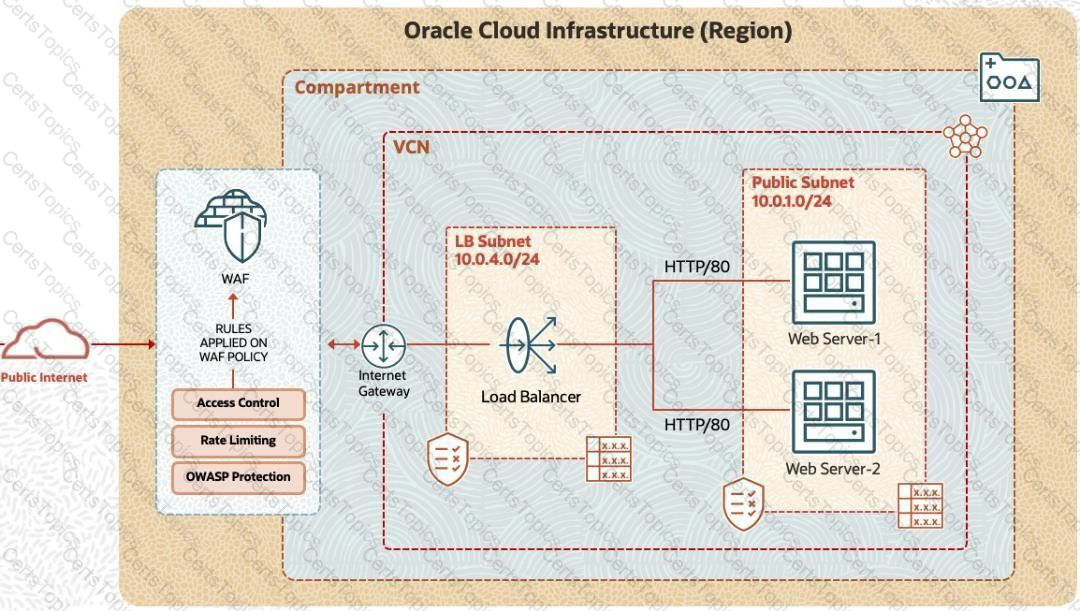
Challenge 3 - Task 1 of 4
Set Up a Bastion Host to Access the Compute Instance in a Private Subnet Scenario
A compute instance is provisioned in a private subnet that is not accessible through the Internet. To access the compute instance resource in a private subnet, you must provide a time-bound SSH session without deploying and maintaining a public subnet and a jump server, which eliminates the hassle and potential attack surface from remote access.
To complete this deployment, you have to perform the following tasks in the environment provisioned for you:
• Configure a Virtual Cloud Network (VCN) and a Private Subnet.
• Provision a Compute Instance in the private subnet and enable Bastion Plugin.
• Create a Bastion and Bastion session.
• Connect to a compute instance using Managed SSH session.
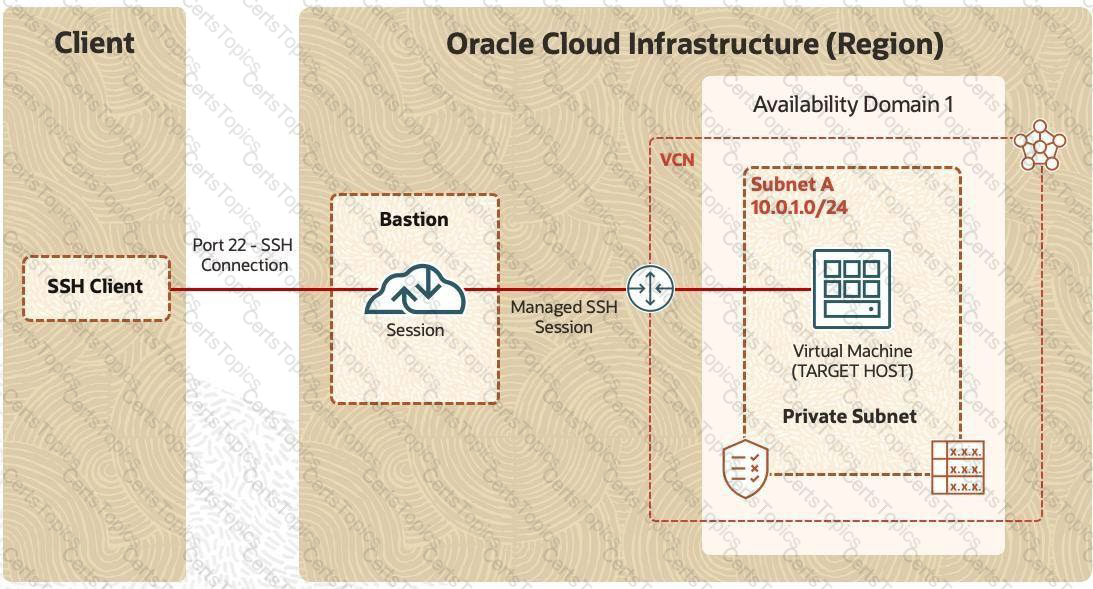
Note: You are provided with access to an OCI Tenancy, an assigned compartment, and OCI credentials. Throughout your exam, ensure to use the assigned Compartment 99233424-C01 and Region us-ashburn-1
Complete the following tasks in the provisioned OCI environment:
Challenge 1 - Task 5 of 5
Authorize OCI Resources to Retrieve the Secret from the Vault
Scenario
You are working on a Python program running on a compute instance that needs to access an external service. To access the external service, the program needs credentials (password). Given that it is not a best security practice, you decide not to hard code the credential in the program. Instead, you store the password (secret) in a vault using the OCI Vault service. The requirement now is to authorize the compute instance so that the Python program can retrieve the password (secret) by making an API call to the OCI Vault.
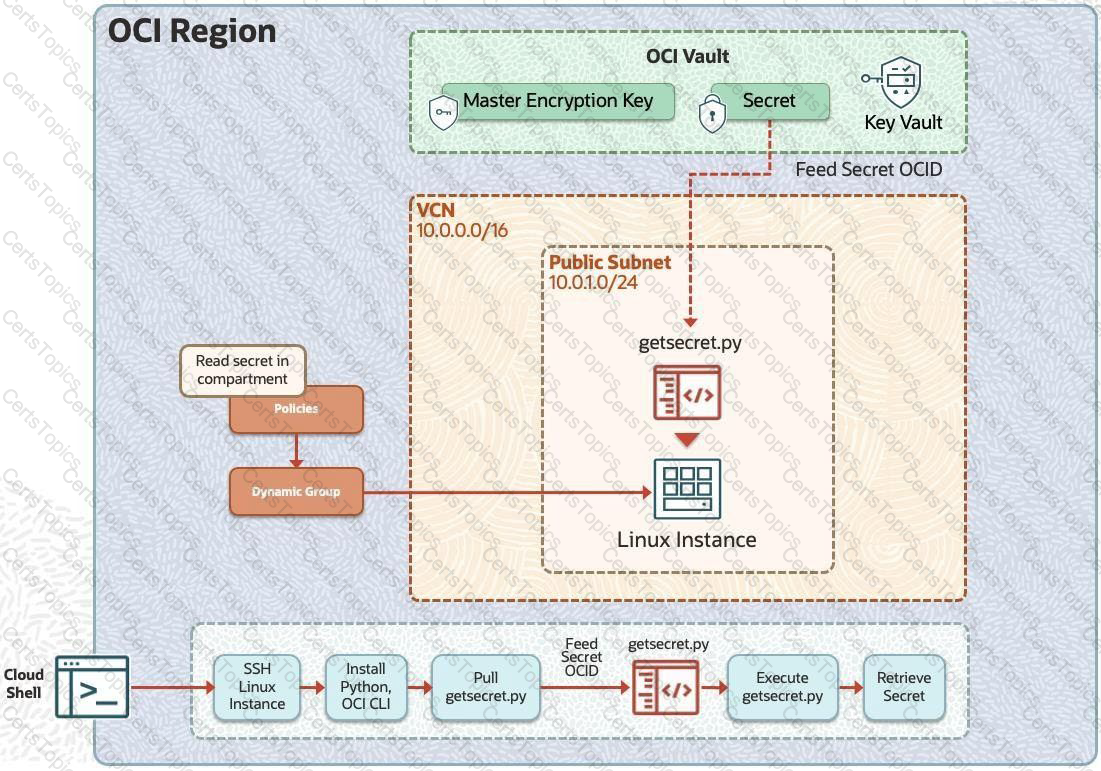
Preconfigured
To complete this requirement, you are provided with:
Note: You are provided with access to an OCI Tenancy, an assigned compartment, and OCI credentials. Throughout your exam, ensure to use the assigned Compartment 99234021-C01 and Region us-ashburn-1.
Challenge 4 - Task 3 of 6
Configure Web Application Firewall to Protect Web Server Against XSS Attack
Scenario
You have to protect web applications hosted on OCI from cross-site scripting (XSS) attacks. You can use the OCI Web Application Firewall (WAF) capabilities to create rules that compare against incoming requests to determine if the request contains an XSS attack payload. If a request is determined to be an attack, WAF should return the HTTP Service Unavailable (503) error.
To ensure that the configured WAF blocks the XSS attack, run the following script: /index.html? ) To complete this deployment, you have to perform the following tasks in the environment provisioned for you: Note: You are provided with access to an OCI Tenancy, an assigned compartment, and OCI credentials. Throughout your exam, ensure to use the assigned Compartment 99233424-C01 and Region us-ashburn-1. Complete the following task in the provisioned OCI environment: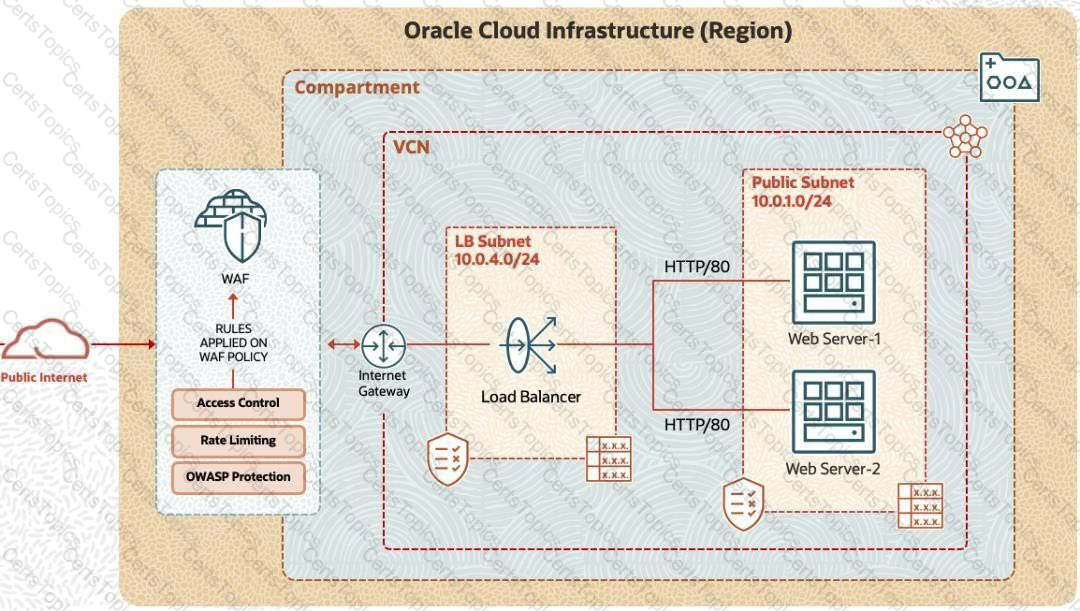
Challenge 4 - Task 2 of 6
Configure Web Application Firewall to Protect Web Server Against XSS Attack
Scenario
You have to protect web applications hosted on OCI from cross-site scripting (XSS) attacks. You can use the OCI Web Application Firewall (WAF) capabilities to create rules that compare against incoming requests to determine if the request contains an XSS attack payload. If a request is determined to be an attack, WAF should return the HTTP Service Unavailable (503) error.
To ensure that the configured WAF blocks the XSS attack, run the following script: /index.html? ) To complete this deployment, you have to perform the following tasks in the environment provisioned for you: Note: You are provided with access to an OCI Tenancy, an assigned compartment, and OCI credentials. Throughout your exam, ensure to use the assigned Compartment 99233424-C01 and Region us-ashburn-1. Complete the following task in the provisioned OCI environment: b. Enable Apache and start Apache server: c. Create a firewall rule to enable HTTP connection through port 80 and reload the firewall: d. Create an index file for your web server: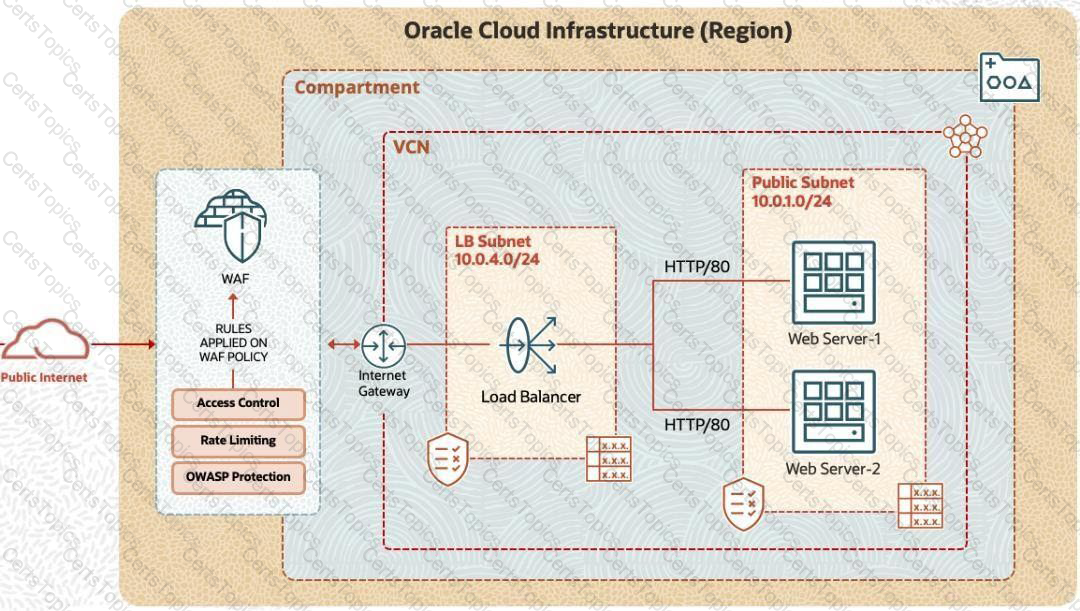
Challenge 2
Least-Privileged Model Enforcement Leveraging Custom Security Zones
Scenario
In deploying a new application, a cloud customer needs to reflect different security postures. If a security zone is enabled with the Maximum Security Zone recipe, the customer will be unable to create or update a resource in the Security Zone if the action violates the attached Maximum Security Zone policy.
As an application requirement, the customer requires a compute instance in the public subnet. You, therefore, need to configure Custom Security Zones that allow the creation of compute instances in the public subnet.
To complete this deployment, you have to perform the following tasks in the environment provisioned for you:
• Create a Custom Security Zone recipe to allow compute instances in the public subnet.
• Create a Security Zone using the Custom Security Zone recipe.
• Configure a Virtual Cloud Network (VCN) and Public Subnet.
• Provision a Compute Instance in the public subnet.
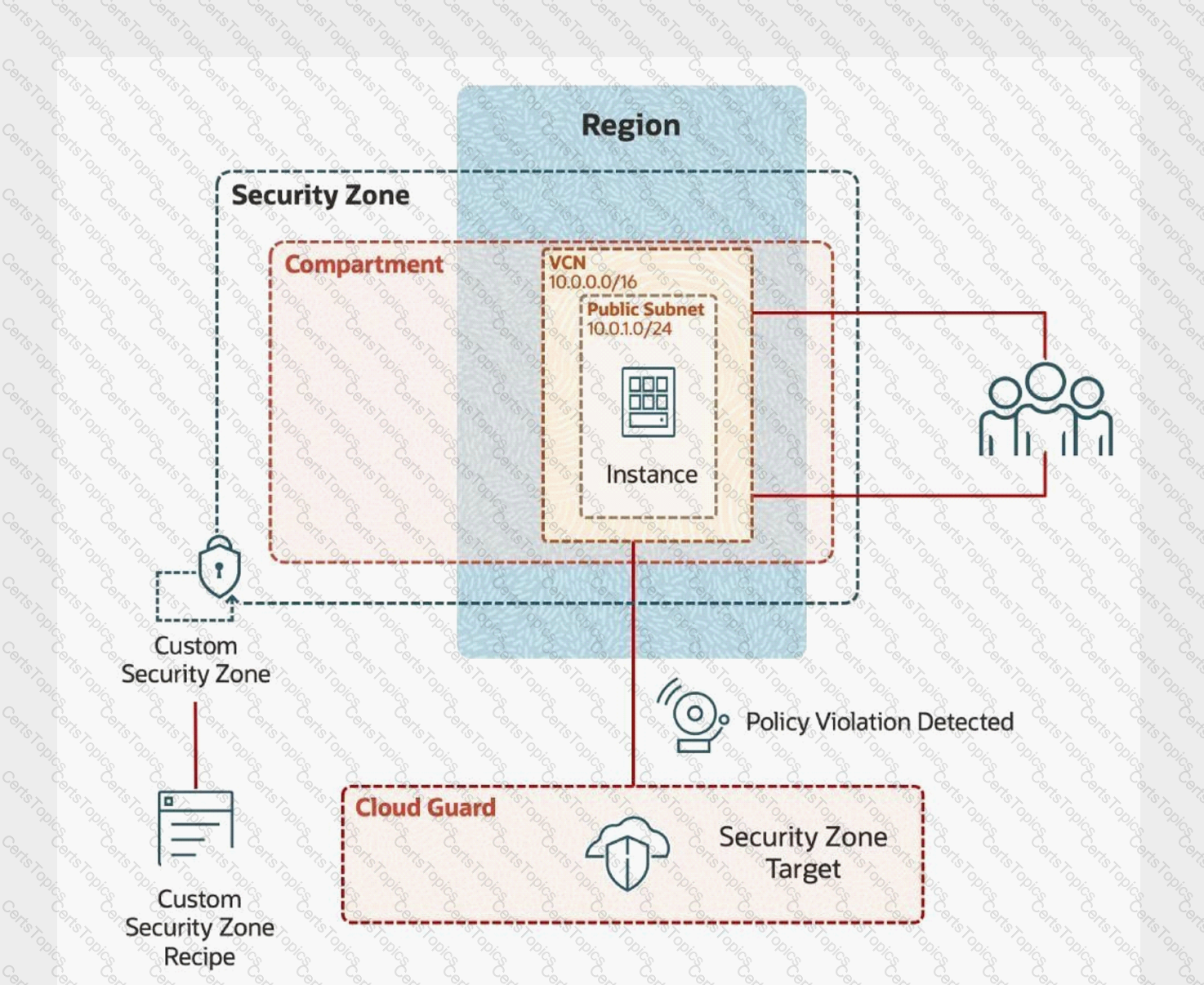
Note: You are provided with access to an OCI Tenancy, an assigned compartment, and OCI credentials. Throughout your exam, ensure to use the assigned Compartment 99234021-C01 and Region us-ashburn-1
Complete the following tasks in the provisioned OCI environment:
Challenge 1 - Task 1 of 5
Authorize OCI Resources to Retrieve the Secret from the Vault
Scenario:
You are working on a Python program running on a compute instance that needs to access an external service. To access the external service, the program needs credentials (password). Given that it is not a best security practice, you decide not to hard code the credential in the program. Instead, you store the password (secret) in a vault using the OCI Vault service. The requirement now is to authorize the compute instance so that the Python program can retrieve the password (secret) by making an API call to the OCI Vault.
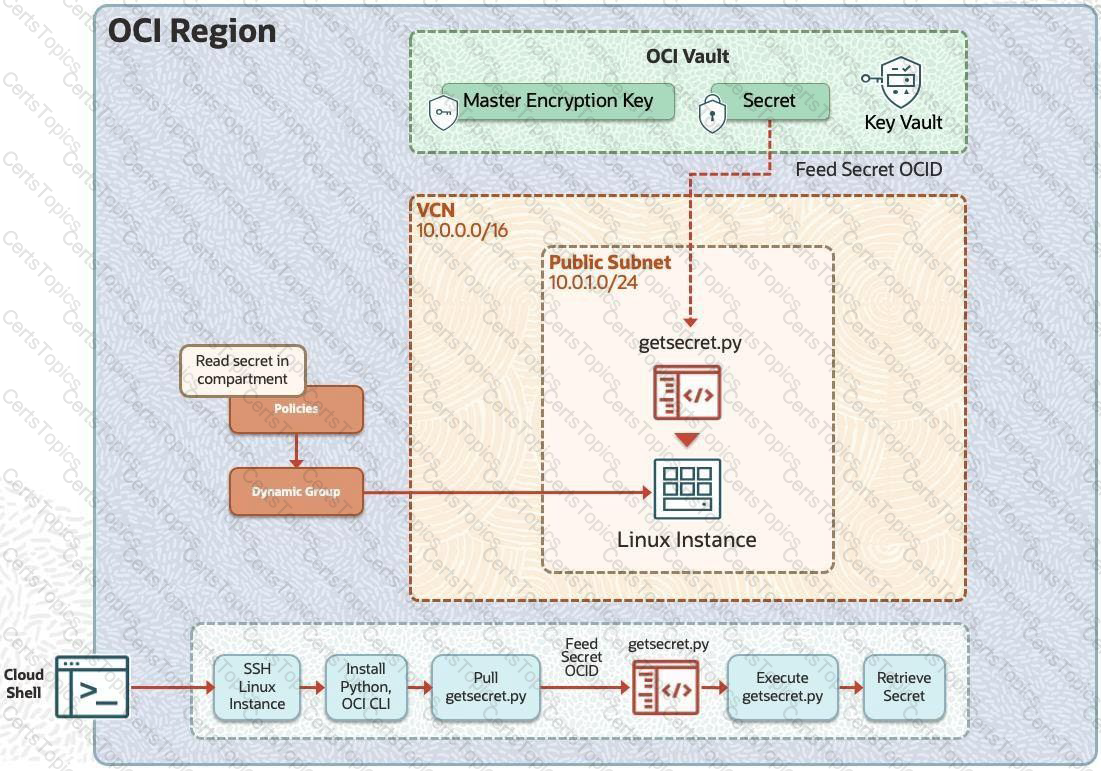
Preconfigured:
To complete this requirement, you are provided with:
Note: You are provided with access to an OCI Tenancy, an assigned compartment, and OCI credentials. Throughout your exam, ensure to use the assigned Compartment 99234021-C01 and Region us-ashburn-1.
Complete the following tasks in the OCI environment provisioned:
For example: If your user name is 99346163-lab.user02, then the secret should be named as my-pbt-secret_99346163-lab.user02.
Challenge 4 - Task 4 of 6
Configure Web Application Firewall to Protect Web Server Against XSS Attack
Scenario
You have to protect web applications hosted on OCI from cross-site scripting (XSS) attacks. You can use the OCI Web Application Firewall (WAF) capabilities to create rules that compare against incoming requests to determine if the request contains an XSS attack payload. If a request is determined to be an attack, WAF should return the HTTP Service Unavailable (503) error.
To ensure that the configured WAF blocks the XSS attack, run the following script: /index.html? ) To complete this deployment, you have to perform the following tasks in the environment provisioned for you: Note: You are provided with access to an OCI Tenancy, an assigned compartment, and OCI credentials. Throughout your exam, ensure to use the assigned Compartment 99233424-C01 and Region us-ashburn-1. Complete the following task in the provisioned OCI environment: Create a WAF policy with the name IAD-SP-PBT-WAF-01_99233424-lab.user01 Eg: IAD-SP-PBT-WAF-01_99232403-lab.user02